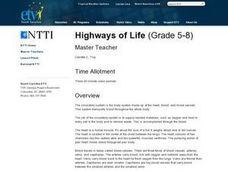Curated OER
Redwood Trees: How Does Water Get to the Top of the Tree
Students discuss photosynthesis. They explore and discuss surface tension, hydrogen bonding and capillary action with hands on experiments. They make journal entries and draw pictures of the different stages of the experiments.
Curated OER
Water Quality
Students investigate the water cycle and evaporation. They study the porosity and permeability of groundwater, and the capillary action in soil in this unit.
Curated OER
Take a Dip: Sticky Water
Pupils complete lab activities to investigate the "sticky" properties of water, such as surface tension and capillary action, due to the polarity of the molecules.
Curated OER
Forces in Liquids
In this forces in liquids activity, students read their notes and answer short answer questions about forces in liquids. Students complete 6 questions total.
Curated OER
The Root Show
Students investigate plant roots. In this plant lesson, students discover the function and structure of plant roots. Students plant a plant in a milk carton with a clear section cut out in order to observe the roots of the plant.
Curated OER
Stalactites And Stalagmites
High schoolers conduct a scientific investigation about the formation of stalactites and stalagmites. They conduct an experiment to reproduce them in the lab environment. Students make observations over a period of time in order to see...
Curated OER
Plant Pigments
Students investigate the components of chlorophyll. They use paper chromatography to separate the many pigments of chlorophyll from one another.
Curated OER
Water - the (Nearly) Universal Solvent
In this water worksheet, students explore the reasons why water is considered a universal solvent. Students compare different ways to change the dissolving rate of a solute. This worksheet has 11 fill in the blank and 8 matching questions.
Curated OER
Paper Chromatography
Middle schoolers investigate the pigments in Magic Markers using chromatography. In this paper chromatography lesson plan, students use absorbent paper and mark the strip with a Magic Marker. They place the strip in a solvent and observe...
Curated OER
Water Properties introduction
Students list items they know and want to know about water on personal K-W-L charts. They describe what happened during the warm up activity in their science journal. Students travel to four different stations and perform the different...
Curated OER
How to tell when mealworms are out of breath
Students explore the respiration rate of a mealworm. Through experimental means, they determine the average volume of oxygen used and discuss factors that affect the respiration rate of an organism.
Curated OER
Plant Science: Introduction to Photosynthesis
Students explore the process of photosynthesis in plants. They discuss the purpose of photosynthesis and its components. Students discuss the importance of photosynthesis for plants and they examine the parts of the plant that play an...
Curated OER
Properties
In this properties instructional activity, learners review the properties of solutions, explain different physical properties, define hydrogen bonding. This instructional activity has 8 problems to solve.
Curated OER
Water - the (Nearly) Universal Solvent
For this solvent worksheet, learners explore why water is considered a universal solvent. Students explore what can change dissolving rates. This worksheet has 8 matching, 3 short answer, 11 fill in the blank, and 4 problems to solve.
Curated OER
Separation of Unknowns in a Liquid
Learners identify the different components of a given sample using chromatography. In this chemistry lesson plan, students compare paper and column chromatography. They collect data and construct data tables.
Curated OER
Highways of Life
Learners explore the circulatory system. They participate in media activities to explore blood flow and identify the parts of the circulatory sytem. Students create a model of the circulatory system.
Curated OER
Separation of Unknowns in a Liquid
Students identify chromatography as method of separating the components of a liquid. Students discover that dyes are composed of more than one component in achieving a particular color in these lessons on paper chromatography.
Other popular searches
- Capillary Action Experiment
- Capillary Action Carnation
- Capillary Action in Plants
- Water Capillary Action
- Capillary Action Plants
- Water and Capillary Action
- Capillary Action and Drought
- Capillary Action Worksheet


















